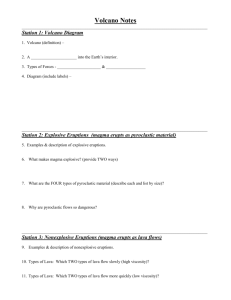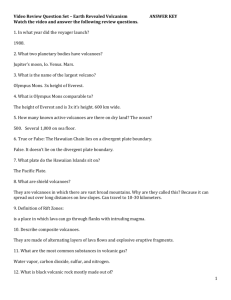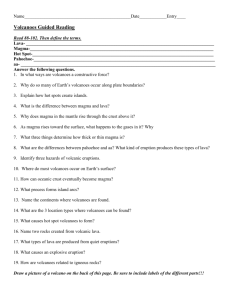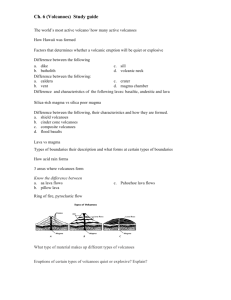volcanoes
advertisement
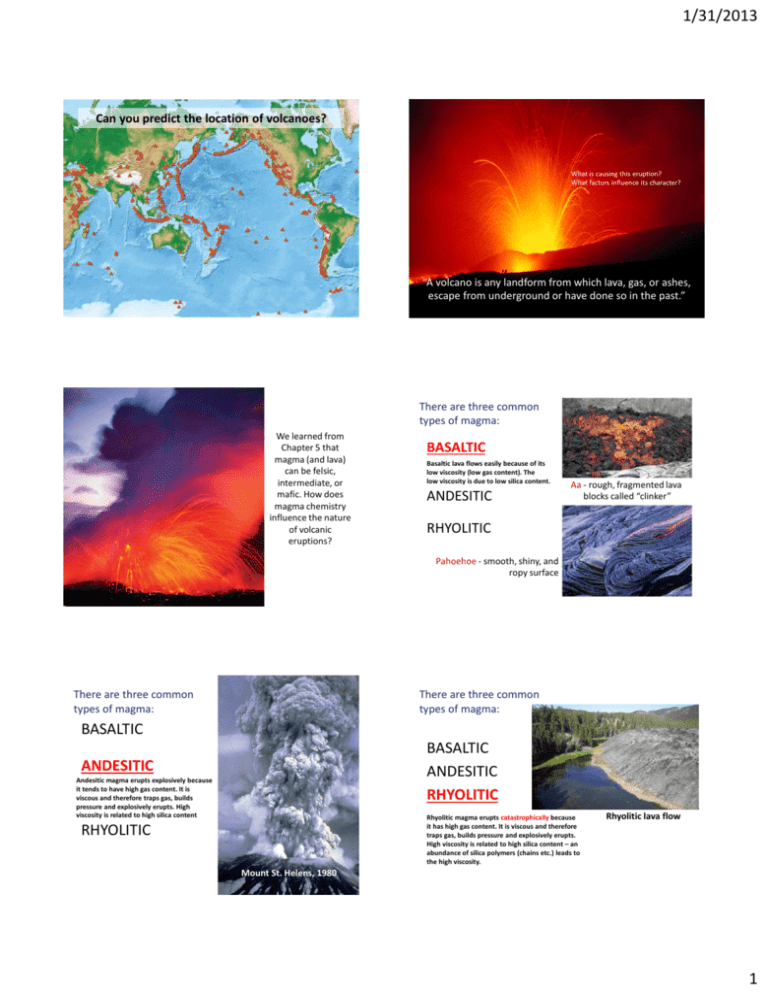
1/31/2013 Can you predict the location of volcanoes? What is causing this eruption? What factors influence its character? “A volcano is any landform from which lava, gas, or ashes, escape from underground or have done so in the past.” There are three common types of magma: We learned from Chapter 5 that magma (and lava) can be felsic, intermediate, or mafic. How does magma chemistry influence the nature of volcanic eruptions? BASALTIC Basaltic lava flows easily because of its low viscosity (low gas content). The low viscosity is due to low silica content. ANDESITIC Aa - rough, fragmented lava blocks called “clinker” RHYOLITIC Pahoehoe - smooth, shiny, and ropy surface There are three common types of magma: There are three common types of magma: BASALTIC BASALTIC ANDESITIC RHYOLITIC ANDESITIC Andesitic magma erupts explosively because it tends to have high gas content. It is viscous and therefore traps gas, builds pressure and explosively erupts. High viscosity is related to high silica content Rhyolitic magma erupts catastrophically because it has high gas content. It is viscous and therefore traps gas, builds pressure and explosively erupts. High viscosity is related to high silica content – an abundance of silica polymers (chains etc.) leads to the high viscosity. RHYOLITIC Rhyolitic lava flow Mount St. Helens, 1980 1 1/31/2013 Comparison of common magma types EXPLOSIVE ERUPTIONS are fueled by violent releases of volcanic gas Pyroclastic debris is produced by explosive eruption Tephra = airborne Pyroclastic Flow = gravity-driven down the slopes A cataclysmic Plinian-style eruption (schematic drawing) Reunion Island EFFUSIVE ERUPTIONS RELATIVELY FLUID LAVA FLOW DETERMINED BY: • viscosity (low) • temperature (high) • gas content of magma (low) http://dsc.discovery.com/videos/ultimate-guide-to-volcanoes-pyroclastic-flow.html http://www.youtube.com/watch?v=yjL7UjogUaI 2 1/31/2013 Volcanic products? Lava, gas, pyroclastic debris Aā 1000 to 1100°C Gases released from a volcano can be as deadly as the hot, fiery lava. Pāhoehoe 1100 to 1200°C Volcanoes can be classified into 6 major types TYPES OF PYROCLASTIC DEBRIS based on their size, shape, and origin Large-scale Volcanic Terrains no central vent network of source material generally massive ASH PUMICE VOLCANIC BOMBS Central Vent Volcanoes central vent summit crater flank eruptions fissure eruptions LAPILLI VOLCANIC BLOCK WELDED TUFF COMPARISON OF SIX TYPES OF VOLCANOES SHIELD VOLCANOES ARE A TYPE OF CENTRAL VENT VOLCANO. Mauna Loa 3 1/31/2013 Shield Volcano Mauna Kea • • • • Low silica, low gas magma originates in the mantle. Fluid, basaltic lava results in “Aa” and “Pahoehoe”. Low viscosity creates broad, gentle slopes. Sometimes, Phreatomagmatic eruptions (rapid expansion of steam) occur when lava contacts water. Hawai‘i • Eight main islands are exposed tips of the Hawaiian Ridge. • Age range is modern to ~6 million years old. • Volcanoes develop on the Pacific Plate as it moves across the Hawaiian Hotspot. Hawai‘i • Hawaiian volcanoes progress through pre-shield Lōʻihi, shield Mauna Loa and Kīlauea, post-shield Mauna Kea, Hualālai, and Haleakalā, erosional Kohala, Lāna‘i, and Wai‘anae, and rejuvenated Ko‘olau and West Maui stages. • As the islands age, they erode and subside, becoming atolls and seamounts. Kauai Ni'ihau Waianae Lōihi Seamount Koolau Mauna Loa Lāna‘i Wailau West Maui Haleakalā Kahoolawe Kohala Hualālai Mauna Kea Mauna Loa Kīlauea Lōihi 4 1/31/2013 Diamond Head Geologists have known for years that pieces of the two shields that make Oahu have been missing Maps of the seafloor indicate that massive landslides have occurred Koolau Shield Our islands are carved by massive landslides Waianae Shield Measurements show the south flank of Kilauea is moving 10 cm/yr to the SE 1975 Kalapana quake shifted the flank 8 m horizontal and 3 m vertical Over 17different landslides have been identified Koolau reconstructed Will the south shore of the Big Island slide?...it already is! 5 1/31/2013 Atoll formation Volcanoes can be classified into 6 major types based on their size, shape, and origin Large-scale Volcanic Terrains no central vent network of source material generally massive Central Vent Volcanoes central vent summit crater flank eruptions fissure eruptions Cinder Cones Composite Volcano or Stratovolcano Layered with lava Flows and ashfall Deposits – massive explosions • high lava fountains on the vents of shield volcanoes. • composed of pyroclastic debris. • caused by high gas content. Mount Mageik, Katmai National Park FEATURES OF STRATOVOLCANOES (composite volcanoes) • • • Mt. Fuji Alternating andesitic lava flows and layers of explosively ejected pyroclastics. Magma is intermediate, making the lava viscous and difficult to erupt. Explosive eruptions due to buildup of gases. 6 1/31/2013 •Steep slopes •Explosive •Irregular outline from past explosions •Andesite magma •Relatively high silica content Lava Dome – a plug that prevents eruption Pressure builds behind the plug until it blows… What happens when the plug is blown? Plinian-style eruption…don’t stick around to watch Mt. Mayon, Philippines Sticky silica-rich magma controls volcano shape, explosivity, and behavior Pyroclastic flows Major atmospheric impacts Volcano is blasted to pieces Lahar Mt. Pinatubo - 1991 7 1/31/2013 FEATURES OF RHYOLITE CALDERA COMPLEXES • High-silica, high-gas magmas. • Massive explosions (most explosive of all types). Aniakchak Caldera Rhyolite Caldera Complexes Are Central Vent Volcanoes. • Collapse, producing an “inverse volcano”, or Caldera (Spanish for cauldron). Large-scale volcanic terrains lack a central vent Monogenetic Fields San Francisco Volcanic Field Poorly understood. Multiple vents and cinder cones. Erupt at different times. Grow laterally. Usually a single magma source Low magma supply San Francisco Volcanic Field 8 1/31/2013 Large Igneous Province Fed by massive mantle plumes Caused by flood basalts (especially fluid basaltic lavas) Discharge over time through long fissures (cracks). Create large plateaus. Flood Basalts – large igneous province Very fluid lava erupting rapidly and with great volume over thousands of years. Columbia River basalts, Deccan Traps, Siberian Traps Do LIP’s mark beginning of hotspots? Columbia River Basalts submarine volcanism Mid-ocean Ridges develop at Spreading Centers Basaltic flow creates global network of interconnected ridges Spreading Center Volcanism Most volcanoes are associated with spreading center volcanism, arc volcanism, or intraplate volcanism Arc Volcanism Explosive rhyolitic, andesitic, and basaltic lavas, divergent plate margins, mid-ocean ridges Spreading Center Volcanism Fluid basaltic lavas, divergent plate margins, midocean ridges Intraplate Volcanism aka” midplate volcanism”, shield volcanoes, rhyolite caldera complexes, and monogenetic fields 9 1/31/2013 10

